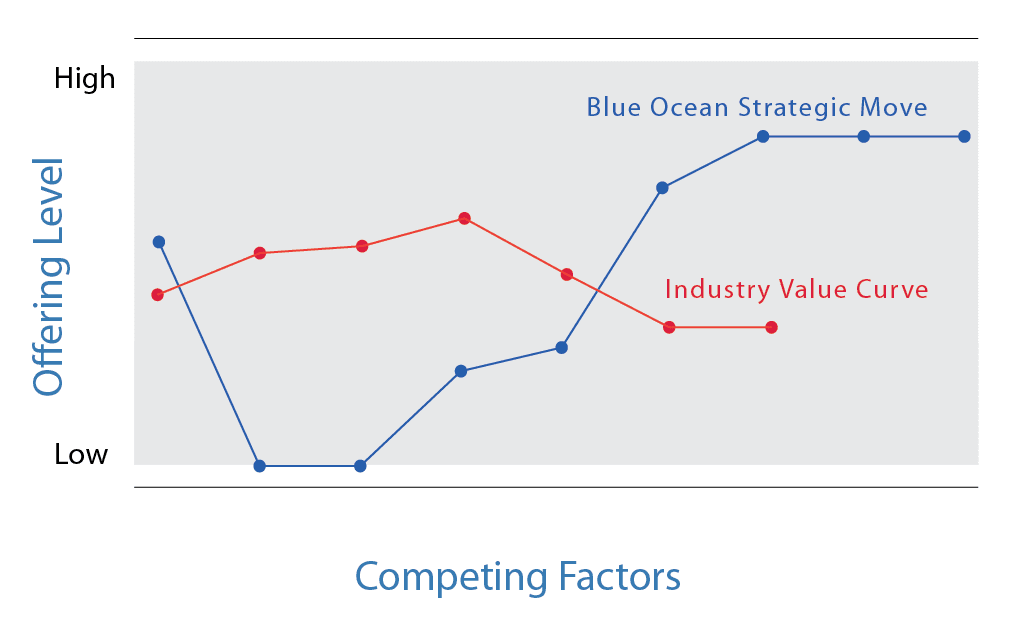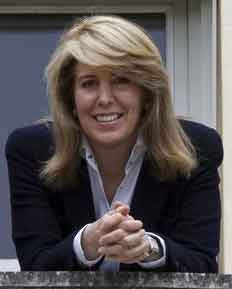The strongest strategic profiles have three complementary qualities:
If a company’s strategic profile does not clearly reveal those qualities, its strategy will likely be muddled, undifferentiated, hard to communicate and costly to execute.
Drawing a strategy canvas shows:

To see how this works, consider Samsung Electronics of Korea. At one of its corporate conferences attended by top managers and CEO Jong Yong Yun, unit heads presented their canvases and implementation plans. Many unit heads argued that the freedom to form future strategies was constrained by the degree of competition they faced. That hypothesis proved to be false when one of the fastest- growing units—the mobile phone business—presented its strategy canvas. Not only did the unit have a distinctive value curve, but it also faced the most intense competition.
CEO Jong Yong Yun saw the dire need to break out of commodity-type competition and create products and businesses that were both differentiated and lower cost. He institutionalized the use of the strategy canvas by establishing the Value Innovation Program (VIP) Center in 1998.
Here, core cross-functional team members of its various business units come together to discuss their strategic projects, typically focusing on strategy canvases. Since the VIP Center was established, Samsung Electronics’ sales have grown from $16.6 billion in 1998 to $216.7 billion in 2013, catapulting the brand to one of the top-ten most valuable globally.
By focusing on the big picture rather than numbers, CEOs mitigate the planning risk of investing lots of time and effort but delivering only tactical red ocean moves, that is, moves within an overcrowded marketplace with shrinking profit margins and limited growth opportunities. This approach consistently produces strategies that unlock the creativity of a wide range of people within an organization and open their eyes to blue oceans, or new, uncontested marketplaces.
When business units present their strategy canvases to one another, they deepen their understanding of the total corporate portfolio, fostering the transfer of strategic best practices across units.
Do your business unit leaders understand the other businesses in your corporate portfolio? Are your strategic best practices poorly communicated across your business units? Are your low-performing units quick to blame their competitive situations for their results? If the answer to any of these questions is yes, try drawing, and then sharing, the strategy canvases of your business units.
See an example of a Strategy Canvas here.
This article is adapted from Blue Ocean Strategy, Expanded Edition: How to Create Uncontested Market Space and Make the Competition Irrelevant by W. Chan Kim and Renée Mauborgne. Copyright 2015. All rights reserved.

 Chan Kim is the Co-Director of the INSEAD Blue Ocean Strategy Institute and a Chair Professor of Strategy and International Management at INSEAD. Renée Mauborgne is the Co-Director of the INSEAD Blue Ocean Strategy Institute, an INSEAD Distinguished Fellow and a professor of strategy at INSEAD.
Chan Kim is the Co-Director of the INSEAD Blue Ocean Strategy Institute and a Chair Professor of Strategy and International Management at INSEAD. Renée Mauborgne is the Co-Director of the INSEAD Blue Ocean Strategy Institute, an INSEAD Distinguished Fellow and a professor of strategy at INSEAD.
Chief Executive Group exists to improve the performance of U.S. CEOs, senior executives and public-company directors, helping you grow your companies, build your communities and strengthen society. Learn more at chiefexecutivegroup.com.
0

1:00 - 5:00 pm
Over 70% of Executives Surveyed Agree: Many Strategic Planning Efforts Lack Systematic Approach Tips for Enhancing Your Strategic Planning Process
Executives expressed frustration with their current strategic planning process. Issues include:
Steve Rutan and Denise Harrison have put together an afternoon workshop that will provide the tools you need to address these concerns. They have worked with hundreds of executives to develop a systematic approach that will enable your team to make better decisions during strategic planning. Steve and Denise will walk you through exercises for prioritizing your lists and steps that will reset and reinvigorate your process. This will be a hands-on workshop that will enable you to think about your business as you use the tools that are being presented. If you are ready for a Strategic Planning tune-up, select this workshop in your registration form. The additional fee of $695 will be added to your total.

2:00 - 5:00 pm
Female leaders face the same issues all leaders do, but they often face additional challenges too. In this peer session, we will facilitate a discussion of best practices and how to overcome common barriers to help women leaders be more effective within and outside their organizations.
Limited space available.

10:30 - 5:00 pm
General’s Retreat at Hermitage Golf Course
Sponsored by UBS
General’s Retreat, built in 1986 with architect Gary Roger Baird, has been voted the “Best Golf Course in Nashville” and is a “must play” when visiting the Nashville, Tennessee area. With the beautiful setting along the Cumberland River, golfers of all capabilities will thoroughly enjoy the golf, scenery and hospitality.
The golf outing fee includes transportation to and from the hotel, greens/cart fees, use of practice facilities, and boxed lunch. The bus will leave the hotel at 10:30 am for a noon shotgun start and return to the hotel after the cocktail reception following the completion of the round.